Melaka Spice
By the time, we hit the main north-south expressway E 1 in Malaysia, my watch shows that it is already 11 o' clock in the morning. Malaysia is spread over a distance of 700 Km in north-south direction, compared to its highest east-west width of only 300 Km. This is why, its main expressway E 1, traverses a distance of almost 770 Km from the southern city of Johar Bahru, to northern town of Bukit Kayu Hitam, located almost on Malaysia-Thailand border. I had a recollection of this road in my mind as a very wide and busy artery, when I had travelled on this expressway about 8 or 10 years before. Today, Somehow, I feel that this 4 lane road is not all that great, as I always remembered it. I give a little thought to this change in my perception. The reason must have been the 6 lane expressway near my home town of Pune in India to Mumbai, which was not even ready during my last travel here on this road. I realize that I am now comparing in my mind, this road with the Pune-Mumbai expressway and that is the reason for this change in perception.
Earlier,
we had crossed the border check point between Singapore and Malaysia
under just 10 minutes. You do not even have to get down from the car.
The road from Singapore to this border point, known as 'Second Link,'
branches off into 4 or 5 lanes near the immigration check point. On
the curb of each lane, a counter has been set up by Singapore
immigration. Just stop the car near any of the counters, hand over
your passports. You can not see what happens inside the counter, but
passports are returned within few minutes. After this, you proceed
ahead on a no-mans land, which is a actually a bridge. On other side
or Malaysian side, again similar counters have been set up by
Malaysian immigration. Repeat the passport handing over procedure and
then slow down near customs counters and if they do not ask you to
stop, just proceed. Perhaps, since prices of most things in
Singapore are much higher than in Malaysia, customs officers are
aware that people may not be be taking any contraband with them from
Singapore to Malaysia and do not really bother you.
Malaysian
expressway E 1, even though slightly narrower than Pune-Mumbai
expressway, is now equipped with smart card sensors on each and every
toll gate. You need to recharge this 'touch and go' toll card, with
requisite amount in Malaysian Ringgits. Thereafter, on every toll
gate, there are small machines available. The smart card is just to
be touched on this machine. The machine automatically debits the toll
amount from the amount stored on the card and opens the barricade in
front. The entire process may take 2 or 3 seconds. In India, we have
to stop the vehicle at the toll gate and give cash to a cashier, who
gives a receipt and then lifts the barricade, easily wasting few
minutes. Comparatively, this is a much better arrangement no doubt.
Speed
limit on this highway is 110 Km per hour, but two wheelers are
allowed on the expressway, which means that cars and other vehicles
have to be driven much more carefully and you can seldom exceed speed
of 60 or 70 Km. Surprisingly, I find that most of the drivers here
tend to follow all traffic rules and drive in correct lane, which
makes things easier. There are pleasant looking green stretches or
lawns on both sides of the expressway, that look regularly mowed. In
a few spots, I can see workers mowing the lawns with machine operated
mowers. Overall, the upkeep and maintenance of the expressway appears
to be of a very high order. The road side scenario appears more
natural or as nature would grow it to my eyes, which are accustomed
to Singapore' disciplined and orderly landscapes, where even the
trees have to grow in orderly fashion like everything else. The
trees, shrubs, growing here on road sides look as nature have made
them: disorderly. Beyond these green lawns and few trees, I can see
all along the road, miles and miles of palm trees. These trees give
palm oil to Malaysia, which is exported and the farmers earn good
money. These vast stretches of palm trees, somehow create a sour
feeling inside me. Economically, these fields might be a boon but
what about the damage to biodiversity here, when only one type of
plant is allowed to grow over hundreds of kilometers.
After
a pleasant journey of about 2 hours, we can see on the road side, the
road sign we are waiting for: which says 'Ayer Keroh exit 1 Km.' We
change the lane and the exit is right ahead. Another 2 second stop at
the toll gate and I see signs, such as smaller residential buildings,
traffic lights in squares, all around me, which indicate that we are
in the vicinity of a medium sized town.
About
a decade ago, I had visited for the first time, a restaurant named as
'Melaka Spice' in the Koregaon Park area of my home town, Pune. After
that visit, I had gone there several times again to enjoy excellent
Thai cuisine. Since then, this name 'Melaka' had held some kind of
fascination for me. Later, some information about a narrow strip of
sea between Malaysia and Indonesia called 'Melaka Straits' came into
my reading. I had decided then, to make a trip to 'Melaka' sometime
in future. Today, my wish was getting fulfilled.
The
scenes on the road are very similar to what one can see in medium
sized towns like 'Sangli' or 'Miraj' in India. Roads, squares and
vehicular traffic are quite comparable. But, people appear to follow
road and lane discipline well. No one seems to follow here horrible
driving habits of drivers from my home town Pune, such as turning
right at green signal, ahead of other vehicles, when the vehicle is
standing in the left lane or suddenly turning left from right lane,
when 'No left turn' board is being displayed. All 2 wheeler riders
are seen riding helmets according to the rules. They do not appear to
face any great hardships that 2 wheeler riders in Pune claim to
face, when asked to wear a helmet. Travelling through heavy traffic
for about 15 or 20 minutes, we finally succeed to reach our hotel.
Our hotel has a tall 25 storey building. We ask the valet to park the
car and enter the hotel. The first thing that I can see is a huge
lobby with two giant sized chandeliers with hundreds of glittering
lights and scores of mirrors placed at several strategic points. The
first views of the hotel are no doubt impressive.

After
finishing all the formalities like check in and handing over baggage
to bell boys etc. I finally reach my room. The room has an oversized
glass window with a crystal clear view. I slide the window curtain
aside. The view outside is absolutely stunning. I can see the
beautiful Melaka river with plenty of water, bending and turning at
several places. On the river banks, Malaysian flags flutter in the
wind. Hidden behind the river turns and bends, are small cottages
with roofs that have been painted brilliant red. All empty spaces
between these little cottages are filled with green foliage and
fully grown, emerald green trees that provide a strikingly attractive
contrast to my eyes. Like any other tropical place, the rains shower
'Melaka' also all the year round, which means that there are no
layers or traces of any dust anywhere, commonly seen in all Indian
towns with possible exception of towns in southern Indian state of
Kerala. This clean, dust free environment is any way a specialty of
all south east Asian towns from Myanmar to Indonesia.
Melaka River
A small cottage on river bank
View from the river bank
After
watching the scene outside, for at least quarter of an hour, we
decide to have lunch first and then leave for sight seeing. Instead
of starting a search for a good place to eat, we take easy way out
and decide to eat a buffet lunch at the hotel itself. Only after
finishing my meal, my thoughts return again to Melaka.
To the
east of Indian peninsula and to the south of Indian state of Mizoram,
a narrow peninsula spreads for thousands of kilometers to south. At
the end or at the tip of this peninsula, lies the island of
Singapore. This long peninsula comprises of 3 independent nations:
Myanmar and Thailand in the north and Malaysia in the south. Melaka
city, located on the western sea board of this peninsula at about
200 Kilometers north of Singapore, is the capital of a
state with similar name, within Malaysian federation. The sea coast
along this land is famous and known as 'Melaka Straits.' On the other
or western side of the straits, lies the 'Sumatra' island of
Indonesia. The shape of the straits between 'Sumatra' and Melaka is
like a funnel. Near about the Melaka city, the straits are only 1,7
mile wide. Through this narrow strip of sea, every year, more than
50000 cargo ships sail and 15 Million barrels of crude oil passes
through Melaka straits every day. Almost 70% of crude oil consumed by
China moves through these straits. It is said that if due to some
reason this sea lane gets closed, half the shipping of the world,
would need to change their shipping routes. All these figures only
show, how important are the Melaka straits to the world's commerce
and trade.
I
drive away all these thoughts from my mind as I have not come here to
study commerce or trade and get ready to step out to the city.
The
first thing that I notice in the old parts of the Melaka city is the
extreme orderliness of the traffic. This is because, except for one
or two major roads, all other roads are one way streets. It becomes a
lot easier for the pedestrians to walk along or cross the streets
because the vehicular traffic keeps flowing only in one direction.
Melaka can be even called as one way city. This traffic arrangement
means that even on curvy, narrow roads in old city, one never
experiences any traffic jams and traffic moves, sometimes slowly but
smoothly. Besides that, I also observe the disciplined way in which
all drivers drive here and follow traffic rules except for the
Tricycle Rickshaws or Trishaws. I feel that this method of
controlling traffic by making most of the streets as one way, might
solve the congestion on streets of my home town, Pune. Few years
back, traffic police in Pune, implemented one way traffic, on two
major streets in the town; J M Road and Fergusson College road, after
a great effort, because almost everyone staying in that area opposed
the plan. But since then, the traffic congestion in that area is a
thing of the past. With that experience, to implement one way traffic
plans in entire city would require a Herculean effort on part of the
Police, but it is well worth trying from what I see here in Melaka.
While
touring the old city, I sense that the city's history and importance
of it's geographical location, keeps blending with the modernity all
the time. This is only a medium sized city with a population of seven
or eight hundred thousand people, what my home town Pune was in
1970's decade. The older parts of this city are all located around
the Melaka port, which means that the history of the city is
concentrated in this area. Like the fort area, built by British, in
the city of Mumbai, a fort existed here also and almost all the sites
worth seeing are well within this fort walls. This makes it easier
for a tourist like me to just walk around and see everything.
I have
already written about the locational importance of Melaka. For this
reason, from historical times, Melaka inhabitants always had
sprinklings of Arab, Indian, Malay and Chinese traders, who used to
camp here. Large consignments of Java spices, Chinese silk, salt,
minerals, perfumes, gold, Chinese ceramics and wine were transshipped
and traded at this port for many centuries. From 1450 CE Sultan of
Melaka ruled over this city. In 1511, a Portuguese armada invaded
Melaka port and finally Sultan had to surrender the port to them.
After this, Melaka became a Portuguese colony. The Portuguese started
controlling the entire trade in the region because of their control
of Melaka. This could not be tolerated by other European powers. In
1641, Portuguese armada and Dutch naval ships fought many a battles
off the coast of Melaka. This naval war was won by the Dutch and they
took control of the port. The British, now firmly in control of
India, could not accept the fact that a port of such great importance
was controlled by Dutch. Naval skirmishes between British and Dutch
navy continued till finally British exchanged areas of Sumatra island
under their control with Dutch in 1824 and took possession of Melaka.
This
300 year occupation of Melaka fort, first by Portuguese, then Dutch
and finally by British has left many ruins of buildings in the fort
area of Melaka. For anyone, who loves history, Melaka fort is like a
gold mine of history. UNESCO has declared Melaka as a World
Heritage Site in 2008. The present Governments of Melaka as well as
federal Government of Malaysia, have fully realized the tourism
potential of this place and have taken up number of development
projects, making Melaka an interesting place for tourists. A holiday
in Melaka is considered by many a tourists as a pleasant and
delightful experience no doubt.
Stadthuys
Town
Center
Since
most of the places of tourist interest in Melaka are around the town
center, I start my walking tour of the city from here only. The town
center consists of a a crimson coloured old structure and a nearby
clock tower. This structure is known here as ' Stadthuys' and was
built by the Dutch rulers in 1650 as Governor's residence. Next to
this structure, an old church built in 1753, stands tall. Both these
buildings have been well maintained and their crimson colour makes
them look monumental and splendid. Because of this colour, this
entire town center area, looks very impressive to say the least. '
Stadthuys' now houses a museum, which displays large number of
artifacts and objects related to Dutch and English rulers. The
exhibits include swords, period furniture, rifles, hand guns,
revolvers, pistols, Gun shots, bullets, Chinese ceramics, terracotta
pots, old plans and models of old fort. I sadly recollect the fact
that my home town of Pune is surely much richer in history. However,
except for private collection in Raja Kelkar Museum, there is no
other museum that tells or describes history of Pune to new
generations. We do not even know how 'Shaniwar Wada,' the grand
palace built by 'Bajirao Peshawa' really looked like. I feel rather
sad at this empathy of my home town people at their history, while I
look at the museum here in 'Stadthuys.'
Down
below, in the 'Town Center,' I can see number of Trishaws standing in
a line. These Trishaws are considered as one of the special
attraction of Melaka. We have Bicycle Rickshaws in Kolkata, India,
but these Trishaws here, have the passenger side car attached to the
side of the Bicycle, instead of at behind as done in Kolkata
Rickshaws. Because of this construction, the passengers can see ahead
without any hinderence and can take photographs at will. These
Trishaws are all highly decorated with plastic flower garlands and
electric lights and dazzle in the nights. They have built in music
systems and mostly play Bolywood film songs, which are very popular,
here in Malaysia. I must admit that 'Stadthuys.' looks strikingly
imposing during night time with floodlights focused on the building,
which bring out the crimson red colour rather well.
Guns
and Gun shots
A
Dutch Pistol
Part
of ramparts of the Dutch fort and guns positioned on it
Around
the Melaka fort, there was a fortification rampart built from stones.
Soldiers with field guns, always used to be on duty on top of the
rampart. A portion of the fortification wall adjoining the Melaka
river has been preserved along with the Guns. I have a look at it and
then carry on to climb a small hill just behind the ' Stadthuys.' On
this hill a Portuguese Captain had built a church in 1521. I climb
the hill and have a look at the ruins of the church, which anyway are
not very important or impressive. To be frank, I am hardly interested
in looking at these ruins. I have taken the trouble of climbing this
hill for only one reason. I want to have a good look at the famous
straits of Melaka, which can not be seen from anywhere else.
Straits
of Melaka; Narrow neck of a bottle
Straits
of Melaka is the only gateway available to enter South China sea from
Indian Ocean and is shaped like a bottle with a narrow neck. Here in
Melaka, this narrow strip of sea is only couple of Kilometers wide. I
can see from the hill top, an almost continuous line of ships sailing
in the straits. This is the real indicator of the volume of ships
sailing through here.
On the
west side of this hill, there is an old gate known as Porta d’
santiago. In 1521, after taking possession of Melaka, the Portuguese
admiral of the fleet, Afonso de Albuquerque had built this majestic
gate and a fortified post behind it. After 1824, during British
rule, the post was demolished. When news of this demolition reached
Warren hastings, then Governor gereral of British India, he ordered
that demolition should be stopped and the ruins should be preserved..
The gate, saved in this way, was later preserved by the British and
then by Malaysians in a very careful manner.
I have
a feeling of deep appreciation for the way, this historic ruin has
been preserved by the Malaysians. In India, many people think that
destroying such signs of historic foreign rule is a great symbol of
their patriotic feelings and nationalism and want to remove all such
old monuments and structures to erase parts of unpleasant history.
Nothing can be further from the truth. There is no such thing as good
history or bad history. If we could preserve history, along with
historic monuments, the future generations could learn about the
errors and mistakes committed in the past. If we destroy all the
signs and symbols of history, how do we learn about the past? What
would happen then is nothing else but repetition of past follies and
errors, again and again.
Porta
d’ santiago
During
my school days, I often walked to my school in Pune city, in the
mornings and crossed a bridge known as 'Lakdi Pool.' I would see
every day, a square built platform paved with stones, standing near
one of the banks of the river 'Mutha.' I often used to wonder about
that platform: who must have built it? and why was it built? In 1961
great floods, this platform was totally destroyed and only few paving
stones could be seen lying around. Later on, I came to know from a
well known historian that Narayanrao Peshwa, one of the Peshwa rulers
of Pune, who was murdered at the orders of his own uncle in a palace
intrigue, was cremated here. His cut limbs were brought here in gunny
bags and then were cremated in a fire. A horrible story no doubt, but
that platform was always the mute witness to that horror story. Now
since it is gone, no one would probably know about this bad part of
history ever.
There
are at least 15 museums around the Town center of Melaka, which
include even museums of stamps and even kites. With the limited time
at my disposal, I can probably manage to visit a few at the most. I
decide to start with the Palace of the Sultan and the museum it
contains.
Better
the vacation spot, quicker goes the time. This is very true and time
for my departure has already arrived rather hurriedly, I keep
thinking. Still, I have to leave Melaka now. We are told that we can
have some high tea before we leave. Actually, right now, neither I
am hungry nor it is the time for my meals. But when on vacation, do
we have to follow routine or rules? Off course not, then why not sit
at home only? I decide to indulge myself in one of the finest
cuisines that the hotel offers. As we leave Melaka, I know that I
shall cherish and remember every small detail of last few days for long time to come.
As I
have mentioned earlier, Melaka port was attacked by a Portuguese
armada in the year 1511 and had defeated the Sultan ruling there. For
100 years prior to this, Melaka was a capital of a Kingdom ruled by a
Sultan in the Malaysian Peninsula. In the year 1400 a Hindu king
known as 'Parameshwar' was ruling over Singapore. He was dethroned
and had to run away from Singapore. Eventually, he arrived at Melaka
and decided to make Melaka as the new capital of his kingdom. At
that time, most of the subjects of this king were also Hindus. In
year 1409, king 'Parameshwar' accepted Islamic religion as a
precondition to his marriage to a Muslim princess, then he accepted a
new name for himself and became known as 'Iskandar Shah.' After this,
most of his citizens also accepted Islamic religion. 'Iskandar
Shah's' descendents ruled over Melaka until 1511 and after their
defeat at the hands of the Portuguese, then ruling Sultan ran away to
Bukit Bintang in Malaysia and then to Sumatra island.
Melaka
Fort
The
new European rulers of Melaka were not able to hold on the importance
and historic glory of the Melaka Port. The trade passing through this
port declined further and further. After the British took over Melaka
port from Dutch, they appointed a figure head Sultan and called him
'Sultan of Johar.' He was asked to look after the affairs,
particularly concerning labour strife between local Malay labour and
Chinese labour brought in for working in Tin mines and rubber
plantations.
The
traditional palace of the sultans of Melaka from 'Iskandar Shah's
dynasty was actually located near the fortified post of 'Porta d’
santiago' built by the Portuguese. After Portuguese defeated the
Sultan, they destroyed this palace totally. In 1984, The Government
of Melaka and the federal Government of Malaysia, rebuilt a new
wooden palace, exactly as per original plans, which luckily remained
conserved and housed a museum of artifacts and objects from the
Sultan era in that building.
I am
walking on my way towards this palace, not very far from the gate of
'Porta d’ santiago.' After seeing this great effort put in by the
Governments of Melaka and Malaysia, my heart is saddened again, as I
remember the empathy of the Government of Maharashtra in India, to
conserve the historic heritage of the city of Pune, my home town. It
is a sad reflection, that leave alone establishing museums etc; even
historic structures are not being conserved and are just allowed to
decay and crumble.
The
villages in Malaysia are known as Kampung. The houses in these
villages are built in an exquisite manner. Thick wooden poles are
made to stand up in the ground by burying their ends, deep under
ground. Horizontal wooden beams are tied or nailed to these poles at
a height about 5 or 6 feet. A wooden hut is constructed on these
horizontal beams. It is easily possible for any one, to walk below a
house in a Kampung. The rebuilt Sultan palace here, looks like a
long series of Kampung houses. built one after other. The central
portion of the palace has a built in stair case, which can take you
the second floor. Since the lowest floor itself is at a height of
about 6 feet, to enter the palace, one needs to climb a flight of
stairs. The palace however, appears very comfortable and suitable for
the hot and sultry equatorial weather.
Sultan's
palace
Bed
Room
A
Tea pot
Royal
Jewelery
The
museum exhibits include a beautiful collection of the attires and
dresses, Jewelery, Ceramics, silverware of those periods. As I have
mentioned above, a large number of traders from different
nationalities had settled down in Melaka. Some of the exhibits show
the distinguishable clothes worn by these traders along with the
items they mainly traded. I have been wandering around this museum
for more than one and half hour and realize that I have yet not had
anything to eat since morning, and reluctantly step back from the
palace.
The
Royal Boat
After
lunch, I decide to visit the Maritime museum, not very far away from
the palace. A Portuguese man-of-war or a warship ' Flor de La Mar '
was sunk off the Melaka harbour in the naval wars between Portuguese
and Dutch. In 1990, Government of Melaka built a replica of the
original warship according to original plans and have housed this
maritime museum in this ship standing on hard ground. In Pune, we
have a club called Boat Club or in Mumbai, there is another club
known as Yacht Club. In both these clubs, I have seen many items used
on ships and boats. That probably is the reason for my subdued level
of interest in this museum. But the warship itself is worth a visit.
They also have many models showing old cargo ships and warships,
which are very noteworthy.
Maritime
museum
A
bridge next to the Maritime Museum takes me to a narrow congested
street. This street is well known and is considered as Melaka's top
tourist attraction. Almost every visitor to Melaka, definitely
visits this street at least once, during his visit. This street is
known as 'Jonkar Street' The street, prima
facie, looks like
Mumbai's famous 'Luhar Chawl Street from a distance, but as I go
nearer, it opens for me a gold mine of antiquities, curios and small
tidbits. No one asks you about buying anything here, You can do
window shopping comfortably even for 2 hours here. In the night,
this street gets converted to a street food mall and is like a street
banquet for foodies, who love southeast Asian food. I keep wandering
on the street and indulge myself with some of the snacks and
purchasing some totally unnecessary stuff. Obviously, making
purchases of such things, is and essential part of any tourism. It is
a great fun, I am sure.
Chinese
labour started arriving in Malaya from Nineteenth century, to work in
Tin mines and rubber plantations. Those arrived, naturally settled
down here later and brought their own Chinese culture and food with
them here. After almost two centuries, the original Chinese food and
culture has got amalgamated with the Malay food and culture to
produce a new food and culture for these people of Chinese origin,
now settled in Malaysia. These Malay Chinese are called here as
'Nonya-Baba' or 'Baba-Nonya' and their special recipes are called as
'Nonya food.' In Melaka city, specialized restaurants have now come
up, who serve 'Nonya' food. I am on my way to have my dinner in one
such joint called 'Ole Sayan,' which specializes in Nonya food.
Nonya
Restaurant (Specially decorated for Deepavali)
The
restaurant is jam packed with a mixed crowd, mostly of Chinese
origin, few Caucasians and sprinkling of other Asians like us. In
Mumbai, we have Udipi restaurants, where taking of orders and
delivery of food is done at super fast speed. This restaurant has a
similar culture. The basic ingredients of Nonya dinner still remain
as made from rice, noodles, chicken and prawns. The dishes are quite
tasty and sumptuous. I order a special Nonya desert after my dinner.
It is called as 'Chandol,' and is made from Noodles made from red
beans flour, palm syrup and frozen coconut milk.
The
Government here is making an earnest effort to create more and more
attractions for the tourists to make Malaka a great tourism spot.
There is a monorail now, that runs along Melaka river. Off course,
one can always take a river cruse. New attractions like Butterfly
park, Amusement Park, have come up. The efforts are being made to
make this a recreational spot, where the whole family can spend few
days of fun. Since Malaysian Ringgit is much cheaper than Singapore
Dollar, Singaporeans find this spot very attractive. However, largest
number of tourists that come to Melaka, appear to be Japanese. Bus
loads of Japanese are seen arriving in Melaka from Japan via Kuala
Lumpur.
Trishaw
River
Cruse
Mono
rail
--------













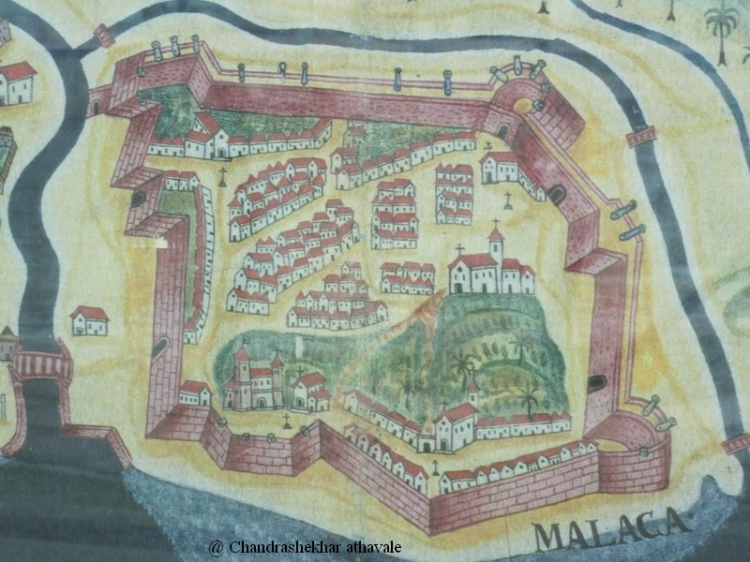
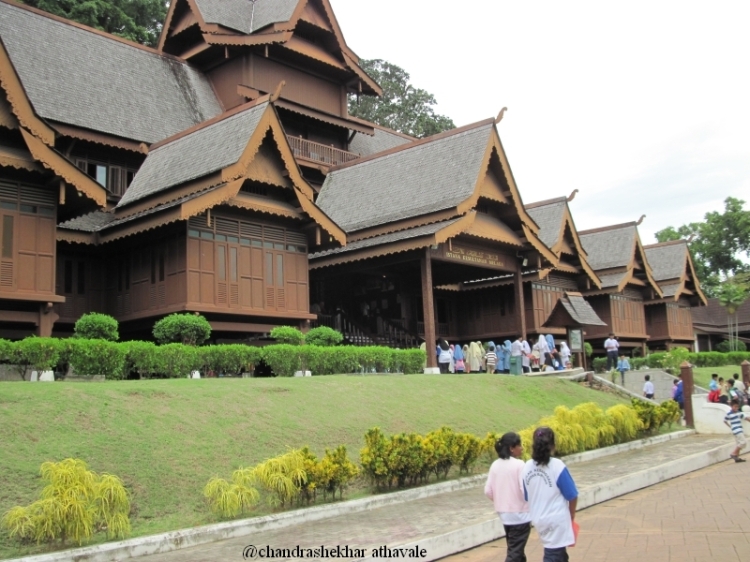
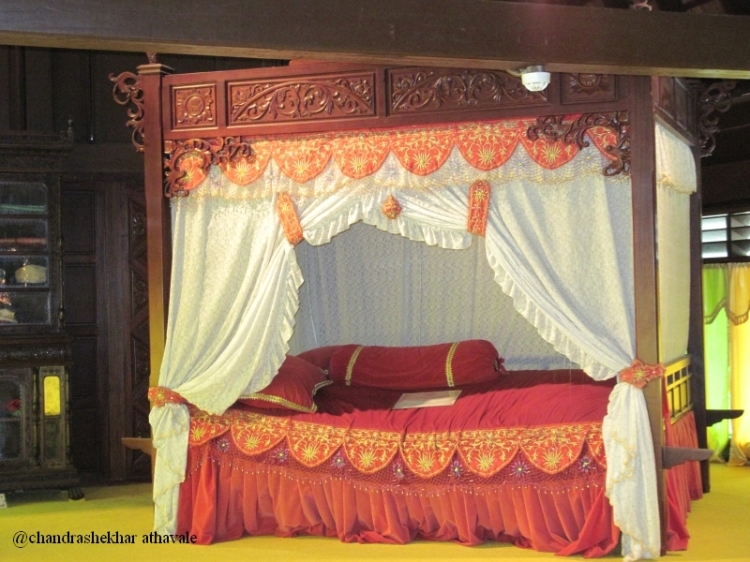
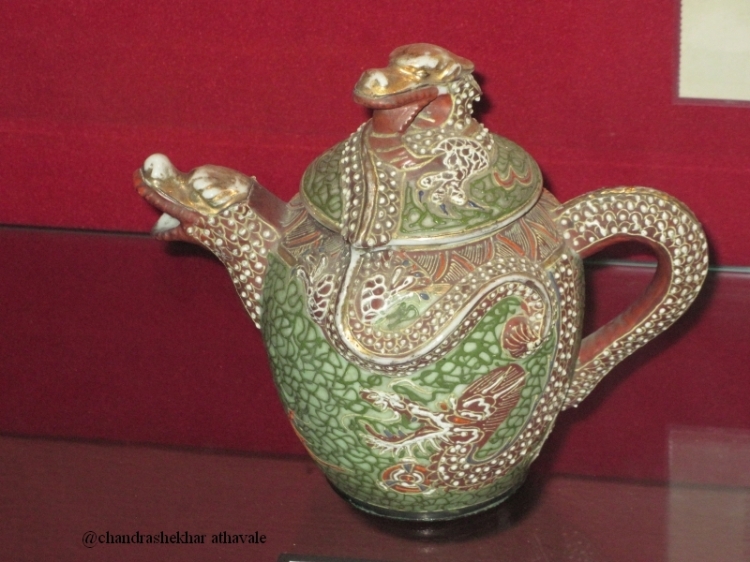


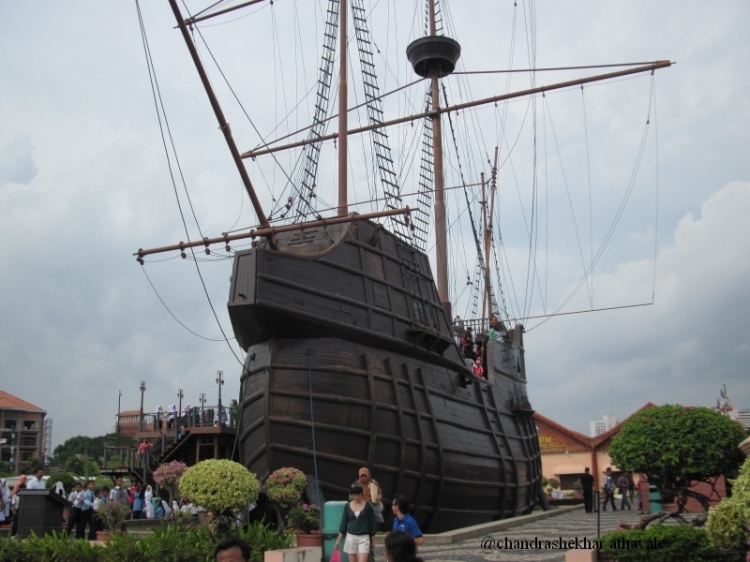
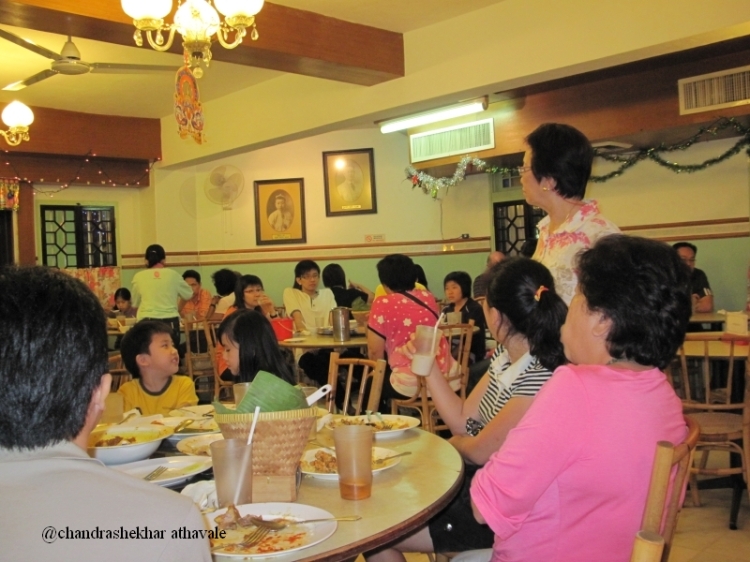
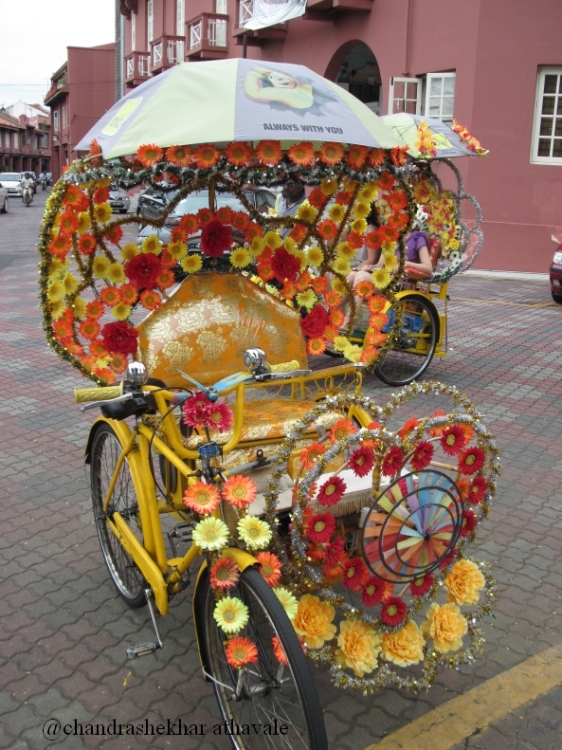


No comments:
Post a Comment